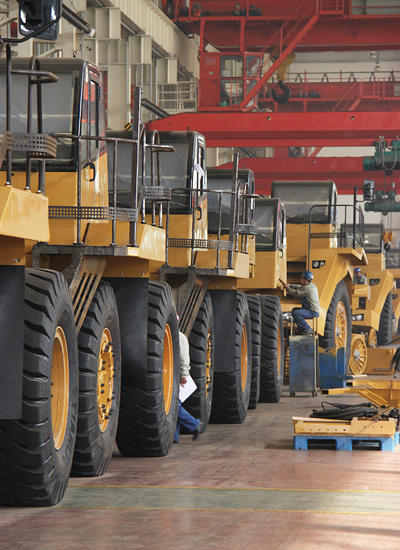 |
|
POWER WHEELS: Heavy machinery sits on a production line at Tianye Tolian Heavy Industry's plant in Qinhuangdao, Hebei Province (BRANDON TAYLOR) |
From technical experts and foreign investors to tourists, Hebei Province is trying to draw in a diverse crowd to fuel its development, encourage growth and establish itself as a major hub for trade and new technologies across Asia and eventually the world. The province is set to switch economic gears from one based on resource-intensive industries to a more hi-tech and eco-friendly model.
The plan is to turn the northeast portion of Hebei Province on the Bohai Sea into a base for modern industry, hi-tech innovation and culture. The coastal development plan recently got the go-ahead from the State Council.
As part of the provincial government's efforts, Hebei will concentrate on expanding iron and steel production, heavy equipment manufacturing, modern logistics, electronic information and tourism in the region, known as the Bohai Rim Economic Circle.
Northeast Hebei has also started absorbing heavy industries from Beijing and Tianjin to alleviate environmental pressures affecting the two municipalities. The moves will allow the businesses and their outdated industrial practices to embrace more green approaches to production and distribution.
Preferential policies have also been put in place in Tangshan and Qinhuangdao to entice heavy industries and hi-tech firms to open new installations along coastal Hebei.
Two hours east of Beijing, the blast furnaces of Tangshan smelt at close to full capacity. The gritty industrial town, widely considered the cradle of China's modern industry, produced about 70 million tons of steel in 2010, approximately one tenth of China's total output, according to the Steel Guru, a website that monitors international iron and steel markets.
Tangshan steel is used in everything from heavy machinery and infrastructure projects to apartments and office buildings.
For most of its history as an industrial boom town, Tangshan has followed a resource-based industrial model, relying almost entirely on its 4.9 billion tons of coal reserves to fuel the steel mills and drive the local economy. The result has been heavy pollution and a deteriorating environment, according to a recent publication from the press office of the Tangshan Municipal Government.
With Tangshan's heavy industries anxious to go global and as a means of embracing sustainable development, the industrial center is looking to the Bohai Sea where a new city is taking shape.
Advertised as an eco-city utilizing the very latest green technology, Caofeidian, just in south of Tangshan, will be the spearhead for Tangshan's and northeast Hebei's, green development trend.
After moving out of Beijing for environmental reasons, Shougang Jingtang United Iron and Steel set up shop in Caofeidian. Operations at the new site officially opened in 2009. Today, Shougang produces 9.7 million tons of steel a year, 1.5 million more than it did under the jurisdiction of the Chinese capital.
Shougang's move is quickly becoming the norm, with steel mills relocating to China's coastal areas as inland water supplies dwindle and pollution in urban centers becomes intolerable. The steel-making process also consumes large amounts of water, providing further justification to establish a presence by the sea, said Ma Xiao, Vice Director of Publicity Department for Shougang.
"Our new steel making processes reduce dust and leave the skies clearer," Ma said. "And one third of the technology we use has been developed internally by the corporation itself."
Shougang's Caofeidian facility makes it easy for raw materials from Australia and Brazil to reach the steel plant and even easier for the company to ship its products out to other parts of China and Asia, Ma said.
| 